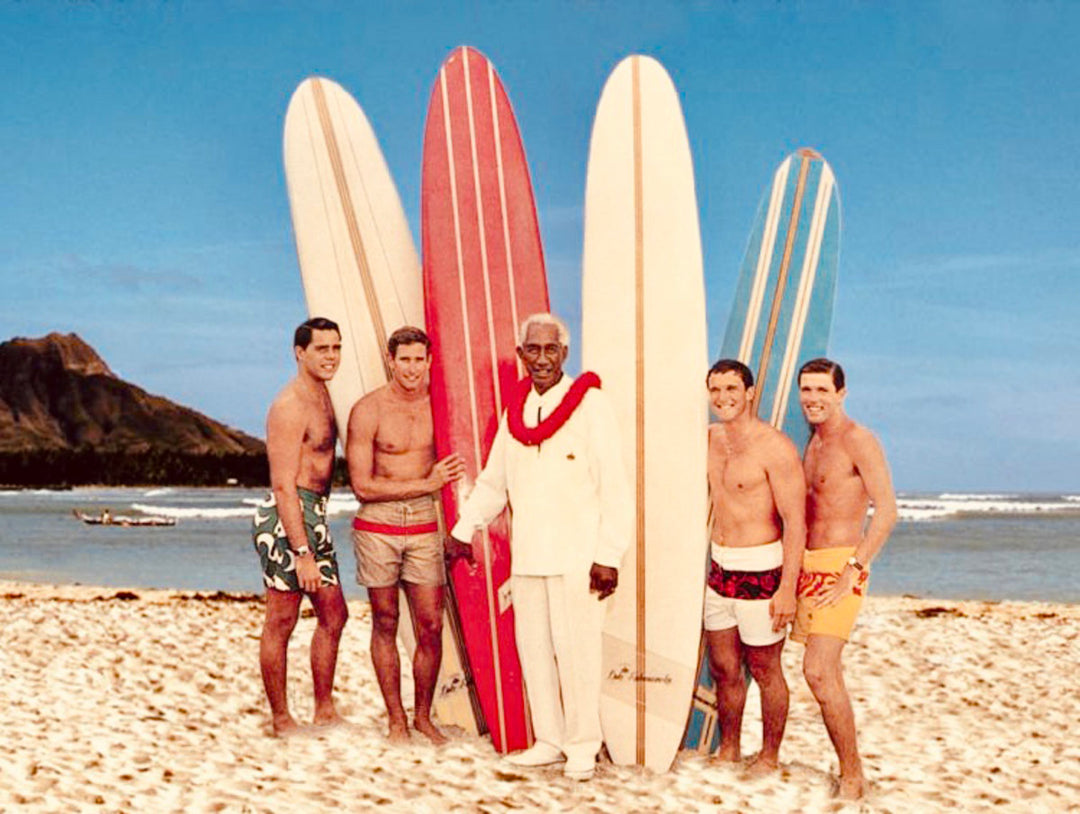THE SURF LEASH
Wisconsin-born surfing pioneer Tom Blake is said to be the first surfer to try a leash. An innovative surfboard builder, surf photographer and writer, Blake was born in 1902 and started surfing in 1921. He was one of the very first to ride Malibu in 1926 – the same year he’s credited with inventing the hollow surfboard. Of his many contributions to surfing, perhaps his most noteworthy came in 1935, when he introduced the stabilizing fin. The comparatively shallow, keel-like fin allowed Blake to ride at a much tighter angle to the wave than ever before. A few years prior, he had developed a surf leash prototype; his original version was made from a 10-foot length of cotton rope that was secured at the waist. Blake quickly abandoned the concept, probably because the thought of being tethered to a 14-foot, 50-pound wooden surfboard didn’t sound like such a good idea.

From Blake’s introduction of the surf leash in the mid- 30s until 70s, several other variations appeared on the surf scene; all received very tepid acceptance by the early surf community. Then in 1970, a pair of Santa Cruz locals – Roger Adams, a regular at Steamer Lane and Pat O’Neill, son of O’Neill Wetsuits founder Jack O’Neill – showed up with a length of surgical tubing attached by a suction cup to the nose of their boards, and looped around their wrists at the
other end.
other end.
The thought was to keep one’s board from washing up against the cliffs above the Lane and to help crank more radical turns as boards became shorter and more maneuverable. This time, the surfing world was more receptive.

By 1971, the suction cup version of the surf leash was supplanted by a more recognizable arrangement; marine grade bungee cord (replacing the stretchy surgical tubing) was attached to the tail of the surfboard and to the surfer’s ankle at the other end. Con Colburn, founder of Con Surfboards and ConTrol Products, is credited with introducing the first commercially available surf leash in about 1975. Called the Power Cord, it was made from 500-pound test nylon cord encased in black rubber. The nylon core limited the Power Cord’s stretch, making it far safer than anything else on the market to date. It was the gold standard of surf leashes until about 1978, when urethane replaced the nylon cord/rubber configuration. With some minor improvements to the late ‘70s design, today’s surf leash remains essentially the same.

In addition to the Power Cord, Colburn’s ConTrol Products Company developed several other innovative products, including a version of Slipcheck (I remember it as kind of like sandpaper in a can, first introduced in 1966) and the leash plug. Prior to the introduction of Colburn’s leash plug, surfers either drilled a hole through the base of their board’s fin or used a special finbox screw fitted with a brass loop. Neither method was very hydrodynamic, and the leash plug improved that to a certain degree.
While the surf leash is considered one of the most significant innovations ever introduced to surfing, it has been a source of some controversy since its more widespread use began in the early ‘70s. A 1972 article entitled “To Leash or Not to Leash” appeared in Surfing magazine, which profiled the division between purists and leash advocates. Some purists maintain that leashes inhibit freedom and give less skilled surfers a false sense of confidence, leading them to paddle out at surf spots they would not otherwise attempt. Furthermore, they believe that use of a leash contributes to crowding in the lineup due to reduced swim time. On the other hand, leash proponents acknowledge that while the leash has been the source of number of injuries over the years, it has still averted far more than it’s caused. Plus, it’s just more fun to be surfing, not swimming.
The surf leash has changed very little since the late ‘70s. It’s still made from some form of urethane rubber, is still attached to the surfboard via a leash plug, and is still fastened to the surfer’s back leg (most often around the ankle, sometimes just below the knee) with a Velcro strap. It has been an important piece of safety equipment for a long time…be careful and be aware of your fellow surfers!
The surf leash has changed very little since the late ‘70s. It’s still made from some form of urethane rubber, is still attached to the surfboard via a leash plug, and is still fastened to the surfer’s back leg (most often around the ankle, sometimes just below the knee) with a Velcro strap. It has been an important piece of safety equipment for a long time…be careful and be aware of your fellow surfers!
Until next time,
Ted
Ted










